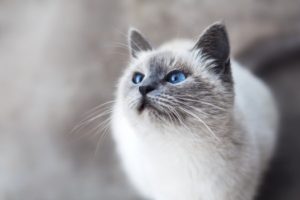Alternately feared and revered, worshipped and reviled, the cat’s natural ability as a mouser ultimately won them a place in the lives and hearts of people.
Now we think of them less as pest control methods and more as members of our family.
But it wasn’t always so. Since the domestication of cats some 5000 years ago, they have been alternately welcomed into our homes and shunned as evil spirits.
It is interesting that the descriptions of the treatment of cats in Egyptian times sounds amazingly similar to our modern treatment, with the fortunate exception of punishment by death for anyone killing a cat.
The Egyptian goddess Bast was part woman, part cat. She represented the sacred eye of Horus, the God of Light. Regular feasts and holidays were celebrated in her honor.
The Romans adopted the cat more readily than other nations of the time. They were probably originally brought there from Egypt.
Roman armies traveled with their animals, including the cats. Some Roman towns were named for the cat.
In 936 the King of Wales enacted laws regarding the monetary value and desired traits of the cat. Expected qualities were to see, hear and kill mice; to have sharp claws and to be able to rear their kittens.
According to the law, if a person purchased a cat and it turned out to not posses one or more of these qualities, the buyer was entitled to a refund.
The cat’s mysterious character probably led to the many myths and superstitions surrounding it.
Cat’s eyes were believed to tell many things – from the time of day to the state of the tides.
Cats were also believed to be clairvoyant, and were used in charms and potions to bestow that talent on people.
Many body parts and substances from the cat were used for healing. The tail was particularly favored. In parts of England it is still used to cure sties.
Nautical superstitions involving cats are numerous. There are also quite a few nautical terms with “cat” in the word – a cat-boat is a small one masted boat; the narrow walk-way on a ship was called the catwalk, and whippings were often carried out using a cat-o-nine-tails.
Cats were believed to both foretell and affect the weather. Throwing a cat overboard was thought to bring about storms at sea.
In the 13th century, witchcraft trials began in Europe. Since cats were often named as a witch’s “familiar” (a spirit helpful to the witch), they acquired at this time an evil reputation.
Black cats were most strongly associated with witchcraft.
A book written in England in 1854 stated that a witch could only take on a feline form nine times. This is most likely the beginning of the myth that cats have nine lives.
Some modern day myths about cats still persist. For instance, while cats are extremely agile, it is not really true that they will always land on their feet.
It was once believed (and may still be) that cats could suck the breath from infants. The truth is that they just like the milky smell.
Though they may like it, milk really isn’t good for cats. A small amount probably won’t hurt, but too much can give both cats and dogs diarrhea.
Many people still believe that a black cat crossing their path brings bad luck.
Cats are inscrutable and mysterious; and can certainly look evil as easily as lovable. But all in all, they are wonderful companions and have been serving and entertaining us well for thousands of years.
